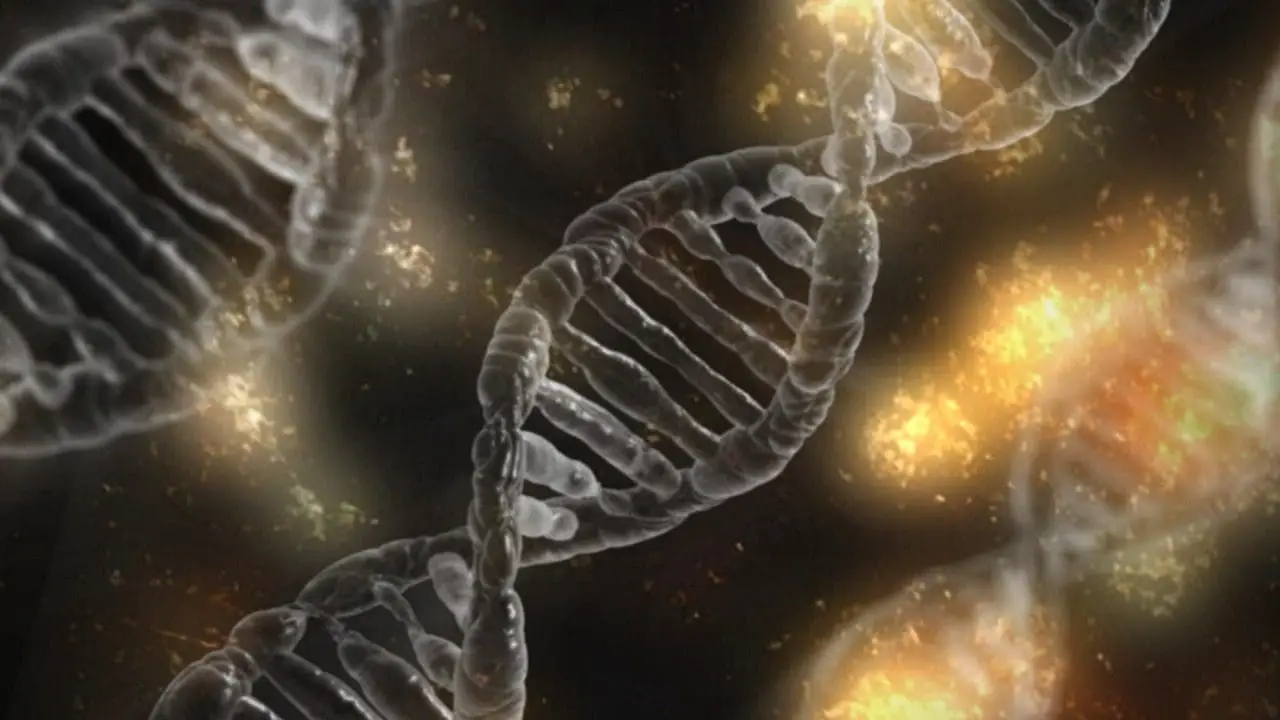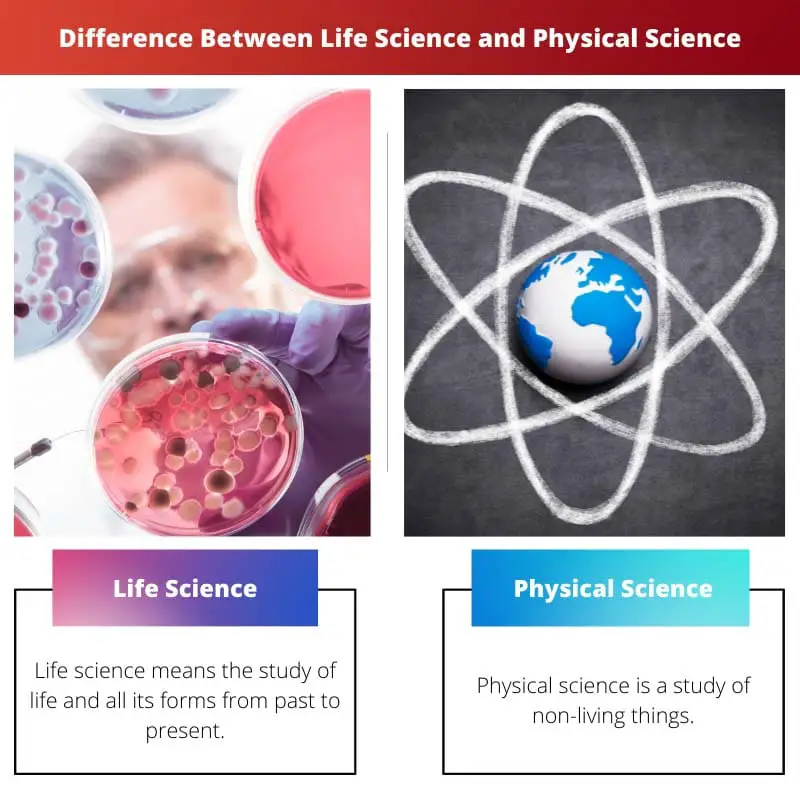Life and physical science help us understand that many different kinds of things exist on the earth, and they could be both living and nonliving.
Life science is a wide subject ranging from the smallest DNA, the nucleic acid, to the largest trees on earth.
Key Takeaways
- Life science studies living organisms, their structure, function, and interactions, including fields like biology, zoology, and botany.
- Physical science studies non-living systems, encompassing physics, chemistry, astronomy, and earth sciences, which deal with matter, energy, and natural phenomena.
- Both branches of science contribute to scientific advancements and breakthroughs. Still, life sciences aim to understand and improve living organisms, while physical sciences investigate the universe’s fundamental principles.
Life Science vs Physical Science
Life science studies living organisms and their interactions with each other and their environment, including biology and ecology. Physical science, which includes physics and chemistry, studies nonliving matter and energy.

Life science means studying life and all its forms from past to present. As the name includes, life is the study of all life, including animals, viruses, bacteria, cells, single-celled organisms, and plants. It studies the biology of living organisms and how they live. A group of specialists also do this study known as biology.
Physical science is a study of a nonliving thing, but a few biological processes are also involved in explaining them fully. The principle of physical science depends upon the laws and theories which explain why this and how occurs and why it does not.
Comparison Table
| Parameter of Comparison | Life science | Physical science |
|---|---|---|
| Meaning | Life science means studying life and all its forms from past to present. As the name includes, life is the study of all life, including animals, viruses, bacteria, cells, single-celled organisms, and plants. It studies the biology of living organisms and how they live. | Physical science is the study of non-living things, but few biological processes are also involved in explaining it fully. The principle of physical science depends upon the laws and theories which explain why this and how occurs and why it does not. |
| Deals with | Life science deals with living things in the world. | Physical science deals with the existence of life on Earth. |
| Subject | Life science has subjects like biology, botany, microbiology, genetics, zoology, etc. | Physical science has a subject like geology, oceanography, chemistry, maths, physics, etc. |
| Study of | Life science studies living objects like plants, animals, humans, organisms, bacteria, and cells. | Physical science is the study of nonliving things, which includes physics, earth science, and astronomy. |
What is Life Science?
Life science is the study of all living organisms’ lives, including the study of animals, plants, and humans.
Although psychology studies the behavioural aspect of the living organism and comes under life science, it includes the biological aspect and instance of this organism to describe this phenomenon.
This science helps to understand the detail of life in general, especially about living organisms. It also helps us to understand the mechanism and principles which govern life on our planet.
The study of this subject has many areas and ranges, including structure and molecules inside organisms to study RNA, DNA, nucleic acids, proteins to organs, cells, and the shapes and size of the organism.
It Is estimated that there are 400,000 different types of plants and 8.7 million different types of animals, and an endless number of viruses and bacteria, as there are many different types of living organisms to study.
Many life science researchers specialise in the organism, and some are specialists in zoology, which have more subspecialties.
There are more than thirty branches of life science; some of them are zoology, botany, microbiology, palaeontology, plant biology, genetics, and it continues.

What is Physical Science?
Physical science is the study of a subject that increases the knowledge of the universe. Physical science is not studying the living organism but focuses on the energy, matter, and different substances.
This study includes the study of microscopic (molecules, atoms), the structure’s study, and the mathematics of some of the largest (stars, sun, and planets).
This describes everything in the universe from the start of time. Some physical science branches are chemistry, physics, astronomy, earth science, geology, planetary science, astrophysics, and meteorology.
It is a systematic study of non-living things despite the study of the organic world in biological science. It consists of four main areas: physics, chemistry, astronomy, and earth science.
These four parts are also divided into subparts.

Main Differences Between Life Science and Physical Science
- Life science and physical science help to understand the earth’s natural habitat.
- Life science deals with the living thing; thus, it studies the organic world. On the other hand, physical science deals with nonliving things; thus, it studies the inorganic world.
- Life science deals with living things in the world. On the other hand, physical science deals with the existence of life on Earth.
- The different subjects in life science are biology, botany, microbiology, genetics, zoology, etc. On the other hand, different physical science subjects are geology, oceanography, chemistry, maths, physics, etc.
- Life science studies living objects like plants, animals, humans, organisms, bacteria, and cells. On the other hand, physical science studies non-living things, including physics, earth science, and astronomy.

- https://books.google.com/books?hl=en&lr=&id=qqKgx47QMX8C&oi=fnd&pg=PA1&dq=difference+between+life+science+and+physical+sciences&ots=fPk-AMRcry&sig=-phUw2XqtRNI-NPtB715m70wMts
- https://www.nature.com/articles/srep01449

The detailed comparison of life and physical sciences in this article provides a comprehensive understanding of their unique aspects.
Absolutely, the depth of analysis is quite impressive.
Certainly, the article effectively illustrates the distinctions between these scientific domains.
I find the article’s explanation of life science and physical science to be thought-provoking and insightful.
Absolutely, and the comparison table is incredibly useful for reference.
Agreed, it provides a clear understanding of these scientific disciplines.
This article provides an in-depth understanding of the key differences between life science and physical science, which is very helpful.
Absolutely, it’s great to have a clear comparison of these essential scientific disciplines.
This is an interesting article. It provides a comprehensive explanation of the differences between life and physical sciences, and their main objectives.
Yes, it’s quite informative and well-structured.
I agree, the detail provided is very enlightening.
The article’s differentiation of life and physical sciences is enlightening and educational.
I agree, the insights provided are intriguing and valuable.
The article’s insights into the differences between life science and physical science are thought-provoking and valuable.
Absolutely, it’s a great read for gaining in-depth knowledge of these scientific disciplines.
Agreed, the level of detail and clarity is commendable.
This article offers a well-structured and clear comparison between life science and physical science, which is highly informative.
Absolutely, it’s a great resource for understanding these scientific disciplines.
Indeed, the depth of information in this article is commendable.
The detailed breakdown of life science and physical science in this article is quite impressive.
Definitely, it’s a well-presented analysis of these scientific fields.
Indeed, the article effectively distinguishes between life science and physical science.
I appreciate the comprehensive comparison that this article provides; it’s very well done.
Yes, it’s refreshing to read such well-researched and high-quality content.
This article is exceptional, it provides a thorough understanding of the characteristics of life science and physical science.